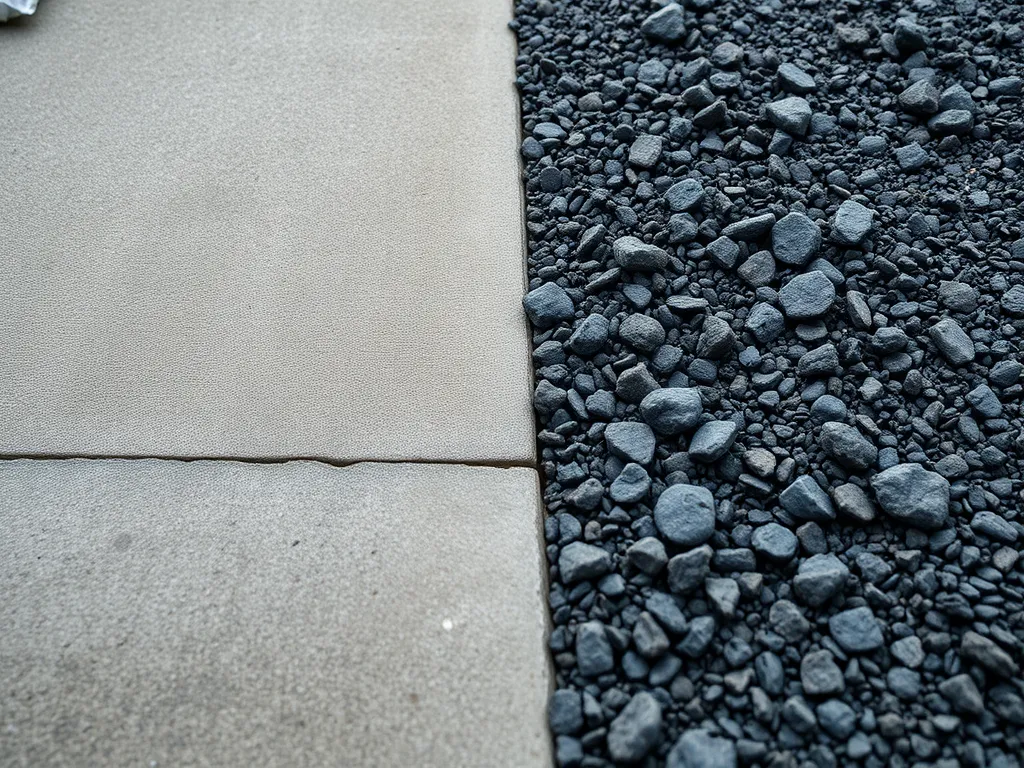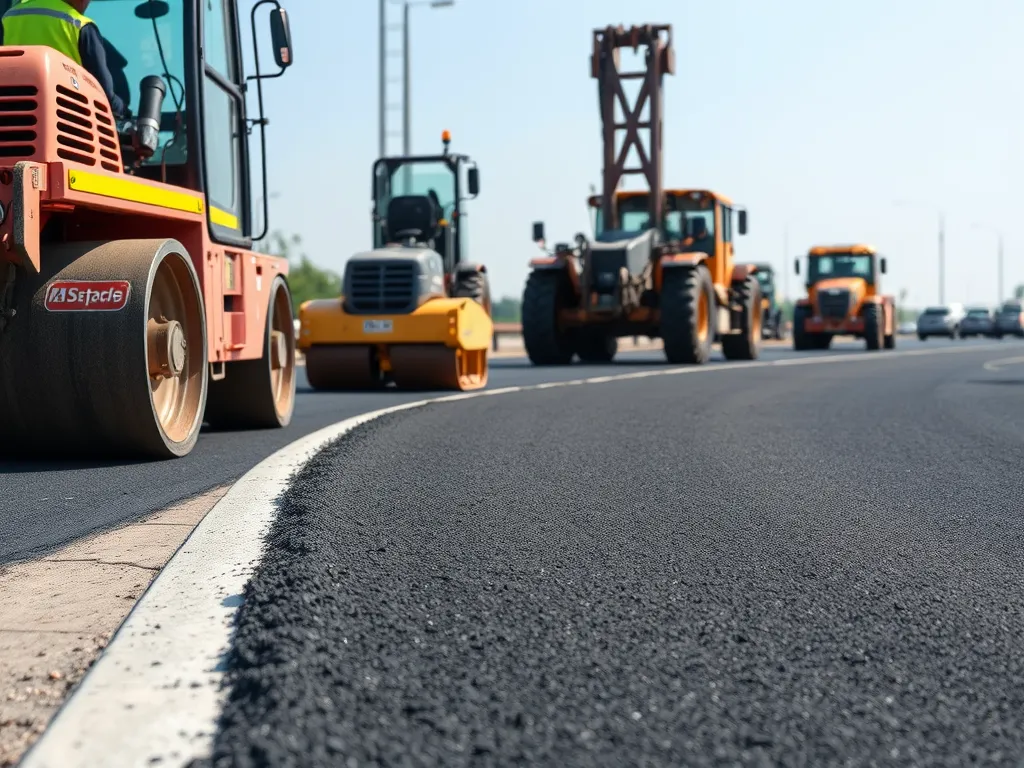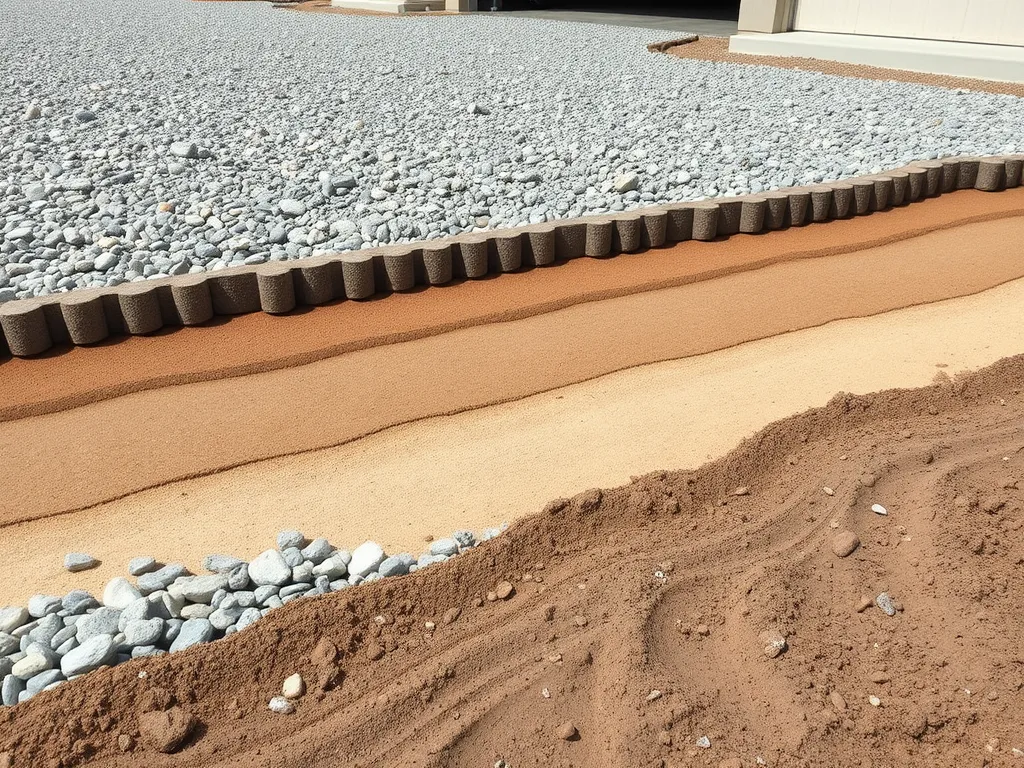Choosing the Right Base Materials for Asphalt Driveways
Published on: October 12, 2025 | Last Updated: April 14, 2025
Written By: George Voss
Base materials form the hidden backbone of asphalt driveways, directly impacting durability and preventing cracks or sinking. These layers of compacted stone, gravel, or recycled materials distribute vehicle weight, manage water runoff, and stabilize the asphalt surface. Crushed stone (3/4″ minus), recycled asphalt pavement (R.A.P.), and Class 5 gravel rank as top choices, each offering distinct advantages in cost ($15-$45 per ton), drainage rates (0.5-2 inches per hour), and load capacity (up to 12,000 lbs per square foot). Climate, soil type, and expected traffic determine which material works best.
This guide breaks down six critical factors for selecting base materials: load ratings, frost resistance, drainage needs, compaction methods (95% Proctor density), thickness requirements (4-8 inches), and cost comparisons. You’ll learn how to match materials like limestone or asphalt grindings to your region’s freeze-thaw cycles, fix drainage issues before paving, and use recycled bases to cut project costs by 20-30%. Let’s explore what makes a base layer succeed or fail under asphalt.
Contents
- Why the Driveway Base Layer Matters for Asphalt Durability
- Driveway Base Material Types for Asphalt Surfaces
- Key Factors for Choosing Driveway Base Materials
- Installing Base Materials for Asphalt Driveways
- Cost Considerations for Asphalt Driveway Base Materials
- Maintaining Asphalt Driveway Base Integrity
- Environmental Impact Of Driveway Base Materials
- Frequently Asked Questions (FAQs)
- Closing Thoughts
- Useful References for You:
Why the Driveway Base Layer Matters for Asphalt Durability
A stable driveway base layer acts as the backbone of your asphalt surface. It carries vehicle weight, redirects water, and prevents shifting that causes cracks. Without proper base materials, even high-quality asphalt mix fails prematurely.
Role Of Base Materials in Asphalt Driveway Stability
Driveway base materials like crushed stone or Class 5 gravel distribute loads across 4-8 inches of compacted layers. Proper gradation (particle size distribution) ensures interlocking stones create a rigid foundation. Contractors achieve 95% Proctor density during compaction – a measure of optimal soil tightness – to resist rutting from cars or trucks. This layer also channels water away through 2% minimum slope grading, reducing frost heave in cold climates.
Consequences Of Poor Base Material Selection
Incorrect driveway base materials lead to alligator cracking (web-shaped fractures) within 1-3 years. Organic soils or loosely packed sand allow 0.5-2 inches of settlement, creating potholes. Poor drainage from non-porous bases causes asphalt erosion, with repair costs running 30-50% higher than initial installation. Substandard bases also void asphalt warranties from most contractors.
Selecting the right driveway base materials sets the stage for evaluating specific material types. Let’s compare crushed stone, recycled asphalt, and other options.
Driveway Base Material Types for Asphalt Surfaces
Selecting proper driveway base material types determines how well asphalt withstands weight and weather. Each option offers unique advantages for asphalt support and longevity.
Crushed Stone
Crushed stone remains the go-to choice for asphalt driveways due to its angular edges and mix of sizes. Commonly graded as ¾” minus, it locks together tightly under compaction.
Recommended Thickness and Gradation for Asphalt Support
Install a 6-8” layer of crushed stone with 95% compaction for residential driveways. Use #57 stone (½” to 1” pieces) as the bottom layer and #8 stone (⅜” to ½”) as the top layer. This creates a stable foundation for 2-3” asphalt layers.
Recycled Asphalt Pavement (R.A.P.)
Recycled asphalt pavement (R.A.P.) uses milled asphalt from old roads, containing 3-5% residual bitumen. This binder reactivates during compaction, creating a semi-bonded base.
Benefits of Using Recycled Asphalt Base Materials
R.A.P. costs 20-30% less than virgin materials while reducing landfill waste. It provides 85-90% of crushed stone’s load capacity at 4-6” thickness. Requires a geotextile fabric separator when used over clay soils.
Class 5 Gravel
Class 5 gravel combines crushed limestone, granite, and sand in specific ratios (MN/DOT 3120-5.2 specification). Its fines content (8-12% passing #200 sieve) aids compaction but demands careful drainage planning.
Compaction Requirements for Asphalt Foundations
Compact Class 5 gravel in 2” lifts using a 10-ton vibratory roller. Achieve 98% Proctor density (ASTM D698) to prevent rutting under asphalt. Test with nuclear density gauges or sand cone tests before paving.
Crushed Concrete Vs. Asphalt Grindings
Crushed concrete (3,000-4,000 PSI) outperforms asphalt grindings (2,500 PSI) in load-bearing but lacks flexibility. Use concrete bases for heavy trucks, asphalt grindings for standard vehicles. Both require 6-8” thickness but differ in drainage – concrete drains 40% faster, grindings need 2% cross-slope grading.
With base materials selected, focus shifts to performance factors like drainage needs and weight demands. Proper pairing of materials with site conditions ensures asphalt stays crack-free for 15-20 years.

Key Factors for Choosing Driveway Base Materials
Selecting the optimal base for your driveway requires balancing technical specs with site-specific needs. Five elements directly impact material performance under pavement surfaces.
Load-bearing Capacity for Vehicle Traffic
Base materials must withstand vehicle weights without shifting. Crushed stone with 1.5″ to 2.5″ angular fragments provides 30-40 PSI stability for trucks or RVs. Light-use driveways work with recycled asphalt pavement (R.A.P.) compacted to 95% density. Class 5 gravel supports up to 8,000 lbs per axle when layered at 6-8 inches thick.
Drainage Requirements for Asphalt Longevity
Water pooling under pavement causes cracks within 2-3 freeze cycles. Bases need 1/8-inch to 3/8-inch void spaces for 12-18 inches per hour drainage rates. Open-graded crushed stone or porous recycled concrete prevents hydrostatic pressure buildup. Install cross slopes of 2% minimum to divert runoff from the subgrade.
Climate Considerations (Freeze-thaw Resistance)
Regions with 15+ freeze-thaw cycles yearly require non-frost-susceptible materials. Crushed granite or limestone resists frost heave better than rounded river gravel. In northern zones, extend base layers 6 inches below frost line depth – typically 36-48 inches in USDA zones 4-5. Southern climates prioritize thermal expansion buffers using flexible R.A.P. bases.
Local Soil Composition and Stability
Clay-heavy soils expand up to 10% when wet, demanding 12-inch gravel bases over geotextile fabric. Sandy soils need 6-inch compacted layers to prevent settling. Conduct proctor density tests: target 90-95% Modified Proctor values for silty soils, 85-90% for granular substrates. Unstable sites might require lime stabilization at 5% mix ratio before base installation.
Cost Vs. Performance Analysis
Crushed stone costs $18-$45 per ton but lasts 25+ years. R.A.P. runs $10-$28 per ton with 15-20 year lifespan. Class 5 gravel at $12-$35 per ton requires more frequent regrading. Factor in delivery fees: recycled materials cut transport costs by 30% versus virgin stone. Balance initial investments against repair frequencies – poor bases triple resurfacing needs within 8 years.
With these factors mapped to your project needs, the next step involves proper installation methods to lock in base performance.
Also See: Cold Mix Asphalt Equipment: Cost-effective Repairs
Installing Base Materials for Asphalt Driveways
Proper setup of your driveway base makes or breaks the asphalt layer. Let’s break down key steps for a rock-solid base.
Site Preparation and Grading Techniques
Start by clearing rocks, roots, and soft spots. Grade the soil to create a flat work area. Use laser levels or string lines to check for high/low zones. Uneven ground leads to weak spots under asphalt.
Optimal Slope for Water Runoff
Slope the base 1-2% away from buildings. That’s 1/8” drop per foot. This angle sheds water fast, stopping puddles that crack asphalt. Add trench drains if soil drains slow (clay holds 0.5” water per hour vs sand’s 8”).
Layer Thickness Guidelines for Asphalt Bases
Crushed stone bases need 4-8” depth. Recycled asphalt bases need 6-12”. Thicker layers handle heavier loads: 8” stone holds 6,000-pound trucks vs 4” for cars. Frost-prone areas? Add 2” extra depth to stop heave damage.
Compaction Methods to Prevent Settlement
Pack base layers in 2” lifts with a vibratory roller (10-ton models work best). For tight spaces, use plate compactors (3,000-6,000 lbs force). Missed spots cause dips – 1” sink lets 25 gallons pool after rain.
Testing Base Density Before Asphalt Application
Check density with a nuclear gauge (measures 95-98% Proctor) or sand cone test. Low density? Recompact. Bases under 92% Proctor fail 3x faster. Test every 500 sq ft for even results.
Get the base right, and your asphalt costs drop 15-30% over 10 years. Next, let’s crunch numbers: smart budget picks for base materials.

Cost Considerations for Asphalt Driveway Base Materials
Smart budgeting for driveway base materials requires balancing quality with project scope. Let’s break down key financial factors.
Material Quantity Calculations Using Asphalt Calculator Tools
Asphalt calculator tools simplify estimating base material needs. Input driveway dimensions (length x width) and desired thickness (typically 4-8 inches for base layers). The tool converts this to cubic yards – standard measurement for aggregates like crushed stone or Class 5 gravel. For a 600 sq.ft. driveway needing 6 inches of base material: 600 x 0.5 (feet) ÷ 27 = ~11.1 cubic yards. Order 12 yards to account for compaction loss.
| Material | Compactable Yield per Ton |
|---|---|
| Crushed Stone | 100-120 sq.ft. at 4″ depth |
| Recycled Asphalt | 90-110 sq.ft. at 4″ depth |
| Class 5 Gravel | 80-100 sq.ft. at 4″ depth |
Comparing Initial Costs Vs. Long-term Maintenance
Crushed stone costs $18-$30 per ton but lasts 20+ years with proper drainage. Recycled asphalt ($12-$20/ton) saves 25% upfront but may require sealcoating every 3-5 years. Class 5 gravel ($15-$25/ton) demands annual regrading in freeze-thaw zones. A $1,500 base layer using premium materials often outperforms a $1,000 installation needing $500 in repairs within 5 years.
Budgeting for Sub-base Vs. Base Layer Materials
Split budgets between sub-base (foundation) and base (load-bearing) layers. Sub-base materials like coarse gravel ($10-$15/ton) improve drainage under the main base layer. Allocate 60% of material costs to higher-grade base materials (crushed stone or R.A.P.). For frost-prone areas, add 2-4 inches of sub-base – increasing total aggregate needs by 15-20%.
Balancing these costs ensures a stable foundation for your asphalt surface. Next, let’s explore strategies to protect your investment through proactive base maintenance.
Maintaining Asphalt Driveway Base Integrity
A strong foundation lasts only if you fix issues quickly. Spotting problems in your driveway’s base stops small flaws from turning into costly asphalt failures.
Identifying and Repairing Base Layer Erosion
Washouts or sinking spots signal base layer erosion. Causes include poor compaction, wrong driveway base material types, or heavy rain. Dig down to inspect sub-layers if asphalt shows cracks over 1/4″ wide. For fixes, remove damaged asphalt, swap washed-out gravel with Class 5 stone or R.A.P., and add geogrid fabric if soil shifts occur. Compact in 4″ lifts using a plate compactor (aim for 95% Proctor density).
Managing Drainage Issues to Protect Asphalt
Water ruins 70% of asphalt driveways through base saturation. Install a 2% slope away from structures and pair with French drains in high-water zones. Use open-graded crushed stone (3/4″ clean) for its 40% void space—triple clay’s drainage capacity. Check downspouts yearly; add catch basins if puddling lasts over 24 hours post-rain.
Preventing Cracks From Base Movement
Base shifts from frost heave or poor installation cause spider cracks. Install 6″ of angular crushed stone (granite or trap rock) for frost zones—its jagged parts lock into place. Apply 2″ sand layers under slabs to absorb minor shifts. For clay soils, mix 6% lime into top 12″ before adding base materials to cut swelling by up to 60%.
Looking at how materials impact surroundings sheds light on long-term costs. Up next: balancing function with planetary care in driveway builds.

Environmental Impact Of Driveway Base Materials
Your pick of driveway base materials shapes both surface life and land health. Let’s break down green choices and smart water flow plans.
Sustainability Of Recycled Asphalt Products
Recycled asphalt pavement (R.A.P.) cuts waste and costs. Old roads get ground into 1-2 inch chunks for new bases. This process uses 95% less energy than fresh mixes. R.A.P. blends with 3-5% new PG 64-22 binder for grip. Builders save $8-$12 per ton versus virgin stone. Since 2020, 85% of U.S. states allow R.A.P. in base layers. It locks in 100% of old tar, stopping soil harm.
Permeability Considerations for Eco-friendly Design
Crushed stone bases drain 3-5 inches of rain per hour. Open-graded R.A.P. rates hit 4-6 inches/hour. Clay soils? They trap water, leading to 70% faster cracks. Smart picks: – 1.5 inch clear stone (40% void space) – 3/4″ gravel with 5% sand (25% voids) Slope bases at 2% grade (1/4 inch per foot) to steer flow. Permeable bases cut storm fees by 15% in 35 states. Avoid fines under 200 sieve size – they clog pores.
Next, let’s explore cost factors tied to these green base picks – from rock math to long-term savings.
Frequently Asked Questions (FAQs)
What is the Best Base Material for an Asphalt Driveway?
The best base material for an asphalt driveway typically varies based on local conditions, but crushed stone, recycled asphalt pavement (R.A.P.), and Class 5 gravel are popular choices. Crushed stone offers excellent drainage and stability, while R.A.P. provides a cost-effective and environmentally friendly option with good load-bearing capacity. Class 5 gravel can also be effective, especially in areas with good drainage.
How Thick Should a Driveway Base Layer Be Under Asphalt?
A driveway base layer should generally be between 4 to 8 inches thick. The thickness depends on the expected load and soil conditions. For areas with heavier vehicle traffic, aim for a thickness of 6 to 8 inches, while lighter traffic can suffice with 4 inches.
Can Recycled Asphalt Be Used As a Base Material?
Yes, recycled asphalt pavement (R.A.P.) can be used as a base material for asphalt driveways. It is cost-effective and has the added benefit of being environmentally friendly, utilizing materials from old roads. When compacted properly, R.A.P. can provide a stable foundation for asphalt layers.
What Drainage Features Are Critical for Asphalt Driveways?
Critical drainage features for asphalt driveways include proper site grading with a minimum slope of 2% away from structures, the installation of trench drains or French drains in high-water areas, and the use of open-graded materials that allow for excellent water flow. These measures help prevent water pooling and reduce the risk of damage to the driveway.
How Does Climate Affect Base Material Selection for Asphalt?
Climate impacts base material selection significantly. In regions with frequent freeze-thaw cycles, non-frost-susceptible materials such as crushed granite are preferable, while in warmer climates, materials that can accommodate thermal expansion, like flexible R.A.P., should be considered. The depth of the base may also need to be increased in colder climates to prevent frost heave.
Closing Thoughts
Choosing the right base materials for your asphalt driveway is paramount. The quality of materials directly affects stability, drainage, and longevity. Crushed stone, recycled asphalt pavement (R.A.P.), and class 5 gravel each present unique advantages. Understanding load-bearing capacity and climate effects is essential for optimal performance.
Taking the time to select appropriate materials will save money and prevent future repairs. Remember to consider factors like soil composition, drainage, and maintenance needs. A well-constructed base layer is the foundation of a durable asphalt driveway.
For further information and tools that help with your driveway project, check out Asphalt Calculator USA.
Useful References for You:
- Huang, Y. H. (2004). Pavement Analysis and Design (2nd ed.). Upper Saddle River, NJ: Pearson/Prentice Hall.
- Learn About 6 Common Types of Driveway Materials
- Essential Guide to Gravel Driveway Materials: Durability & …
- The Best Material for a Dirt Driveway: A Comprehensive Guide – Hello Gravel
- Driveways guide – how to choose the right materials and style


